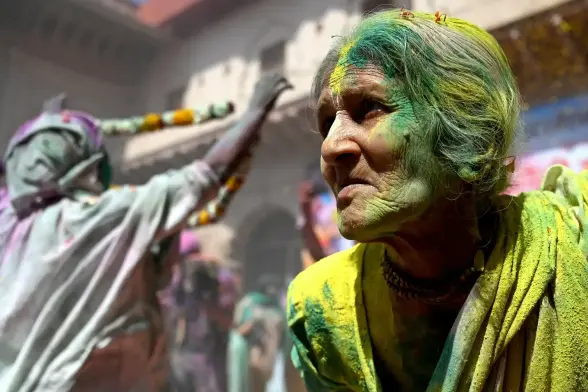#Widows
Widows are covered with coloured powder as they celebrate Holi, the Hindu spring festival of colours, in the northern state of Uttar Pradesh, Vrindavan, #India
Photograph: Money Sharma/AFP/Getty Images
10 important Indian films on the nature of widowhood

Water (Hindi: जल, romanized: Jal) is a 2005 drama film written and directed by Deepa Mehta, with screenplay by Anurag Kashyap. It is set in 1938 and explores the lives of widows at an ashram in India.
Water is a dark introspect into the tales of rural Indian widows in the 1940s and covers controversial subjects such as child marriage, misogyny and ostracism.

Susila Pandey, 70, feeds a cow while on her morning walk – cows are sacred animals in Hinduism.
Women enjoy a peaceful morning boat ride on the Yamuna River, singing religious songs.
Widows rest in the shade of a tree after visiting a temple complex.
One of the widows tries to encourage a woman living on the streets to come to stay with her in a shelter. There is homelessness among the widows of #Vrindavan, and some are too traumatised by their past to be able to cope in the structured environment of a hostel.
Tulsi Rani Dey, 70, left, and Savitri Senapati, 65. In Vrindavan’s shelters the women offer one another comfort, support and friendship.
A widow with a flower she has picked to offer the deities during daily prayers.
Yamuna Dasi, 80, affectionately called Yamuna Ma (mother), takes part in a daily ritual shared by many women in Vrindavan. Each morning, Yamuna Ma and others take long walks around the many temples in the area, praying and chanting.
Vishakha Devi, 75, prays over a small oil lamp. The women often find strength through their faith. Most of the women are Hindu, although some are Sikhs. For many, spirituality becomes a source of resilience and they find solace through daily rituals and prayers.
In Maitri ashram, women gather in the hallway for kirtan, a collective call-and-response chant.
Widows wait outside Maitri ashram for a charitable distribution of milk and fruit. The ashram provides a home and meals for older widows in #Vrindavan
Clad mostly in white and abstaining from celebrations, widows can be seen as bad luck. Many do not have identity cards and cannot vote, so are ignored by the authorities, leaving them excluded from welfare and support services. Many women in #Vrindavan struggle with depression, loneliness and isolation. They can find it hard to make friends, often longing for their past lives and blaming themselves for their misfortune.
Widows have been gathering in Vrindavan since the 16th-century social reformer and Hindu saint Chaitanya Mahaprabhu brought a group to the city to escape the now-banned practice of sati, where widows have to immolate themselves on their husbands’ funeral pyres.
Solace and sisterhood: the Indian holy city where ostracised widows find a new home
Women from all over West Bengal and beyond travel to #Vrindavan for a life of prayer, many having suffered abuse, stigma and abandonment by families who see them as cursed. Up to 20,000 widows – nearly 20% of the city’s population – have found refuge in ashrams and shelters that have sprung up to support them
Words and photographs by Rana Pandey


















